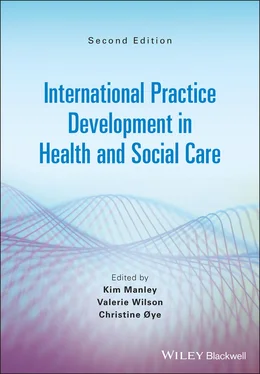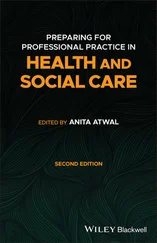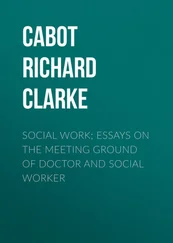1 ...6 7 8 10 11 12 ...18 32 McCormack, B., Manley, K. and Walsh, K. (2008). Person‐centred systems and processes. In: International Practice Development in Nursing and Healthcare (eds. K. Manley, B. McCormack and V. Wilson), 17–58. Oxford: Blackwell Publishing.
33 McCormack, B. and McCance, T. (2010). Person‐Centred Nursing: Theory and Practice. Chichester: John Wiley & Sons Ltd.
34 McCormack, B. and McCance, T. eds. (2016). Person‐centred Practice in Nursing and Healthcare. Oxford: John Wiley & Sons Ltd.
35 McCormack, B. and Titchen, A. (2006). Critical creativity: melding, exploding, blending. Educational Action Research 14 (2): 239–266.
36 McCormack, B., Wright, J., Dewar, B. et al. (2007). A realist synthesis of the evidence relating to practice development: findings from the literature analysis. Practice Development in Health Care 6 (1): 25–55.
37 New South Wales [NSW] (2014). Essentials of Care: working with the Essentials of Care program. A resource for facilitators. 2nd Edition January 2014. NSW Ministry of Health. https://www.health.nsw.gov.au/nursing/culture/Documents/eoc‐facilitation‐resources.pdf(accessed 24 June 2020).
38 Owen, L. (2016). Emerging from physiotherapy practice, masters‐level education and returning to practice: a critical reflection based on Mezirow’s transformative learning theory. International Practice Development Journal 6 (2). https://doi.org/10.19043/ipdj.62.011
39 Øye, C., Thorkildsen, K.M. and Oddgeir Synnes, O. (2020). Critical perspectives on person, care and ageing: unmasking their interconnections. International Practice Development Journal 10 (Suppl, introductory article). https://doi.org/10.19043/ipdj.10Suppl.001
40 Slater, P., McCormack, B. and McCance, T. (2017). The development and testing of the Person‐centred Practice Inventory – Staff (PCPI‐S). International Journal for Quality in Health Care 29 (4): 541–547.
41 West, M. (2016). Creating a workplace where NHS staff can flourish. https://www.kingsfund.org.uk/blog/2016/01/creating‐workplace‐where‐staff‐can‐flourish(accessed 15 June 2020).
42 Wilson, V. and McCance, T. (2015). Good enough evaluation. International Practice Development Journal 5 (Special Issue on person‐centredness, Article 10). DOI: 10.19043/ipdj.5SP.012
43 Wilson, V. and McCormack, B. (2006). Critical realism as emancipatory action: the case for realistic evaluation in practice development. Nursing Philosophy 7 (1): 45–57.
44 World Health Organization [WHO] (2015). WHO global strategy on people‐centred and integrated health services. Interim report. Geneva, Switzerland: World Health Organization. http://apps.who.int/iris/bitstream/10665/155002/1/WHO_HIS_SDS_2015.6_eng.pdf(accessed 20 January 2020).
2. Shaping Health Services Through True Collaboration Between Professional Providers and Service Users
Kristin Ådnøy Eriksen, Julia Kittscha, and Greg Fairbrother
In this chapter we present two different examples of true collaboration between health service providers and health service users (consumers). The notion of authentic partnership between healthcare users and service‐providing professionals has been promoted by both stakeholder groups for some time now. This partnership goal represents a paradigm shift from prior paternalistic approaches which tended to distance patients and providers under the ‘medical model’, which prized examination and observation at the expense of relationality and wholism (Barbour 1995). Research findings increasingly support the efficacy of such a shift, in clinical outcome, patient satisfaction and cost terms (WHO 2015). Its essential collaborative drive favours closer and more genuine partnership relationships between providers and consumers. Collaboration represents ‘evolving processes whereby two or more social entities actively and reciprocally engage in joint activities aimed at achieving at least one shared goal’ (Bedwell et al. 2012, p. 130). True collaboration between professional providers and service users mean striving for reciprocity and requires active, mutual engagement from the involved parties. One party dictating or controlling another party cannot be considered collaboration. This type of engagement would better be described as delegation or coercion (Bedwell et al. 2012).
The drive towards greater collaboration naturally implicates healthcare and community/advocacy organisations, as well as clinicians and individual consumers themselves. People who have chronic conditions have more contact with providers and systems, often carry a prolonged quality of life burden, and are natural protagonists in the development of forward‐leaning groupings and actions which promote better partnerships.
Key concerns of contemporary patient/provider partnership models relate to: i) practice development (PD) and service improvement (how can this be driven in a more consumer‐centred way?) (Hall et al. 2018); ii) clinician education (how can consumers be productively involved in this?) (Olasij et al. 2019); iii) clinical policy (how can consumer input be fostered?) (Nilsen et al. 2006; Ocloo and Matthews 2016); and iv) research (how can consumers be brought in to the healthcare research community on an equal footing, as investigators?) (Gray‐Burrows et al. 2018). Re‐balancing power relations and promoting empowerment are key action areas proposed today. Barriers to such progress in our health systems have been identified. These include tokenism, stigmatising, inadequate information, professional gatekeeping and financial barriers to involvement. Enablers of progress located in Ocloo and Matthews’ narrative review (2016) include improving access (or ways into) the workings of healthcare organisations, providing patient support which is confidence building, offering different forms of involvement, resourcing outreach efforts, working on health literacy and working on communication practices more generally. Making high‐quality, condition‐specific information accessible to consumers in multiple forms and contexts (particularly by supporting the growth of strong information‐sharing peer networks) is increasingly understood to be vital in driving progress (Ramsey et al. 2017). Information is the essential seed from which knowledge and knowledge sharing can grow. A specific kind of information, patient feedback/perception data, is a further area which is gaining increasing attention in person‐centred care modelling. Better and more partnered approaches to this have been shown to yield benefits to both patients and providers, as the tools used become more relevant, and trust is built and acted upon across the patient–provider divide (Hall et al. 2018; Renedo et al. 2015).
Today’s drive towards more inclusive approaches to healthcare delivery is understood to be essential to progress in health organisations. People (particularly those with chronic and long‐term conditions) need and wish to take responsibility for their conditions and share in decision‐making about their treatment and management (Smith and Dransfield 2019). New and innovative models of care which prize partnership and peer networking are emerging. Models informed by PD principles are prominent among these (Heggdal 2015; Collier 2016). Existing studies of new models have yielded positive results for both patients and systems, but further studies which describe modelled approaches and the results arising from these are needed (Hall et al. 2018).
Examples of collaborative approaches
The two case studies presented in this chapter seek to illustrate such inclusive approaches. In both cases, people with long‐term conditions are provided with group‐based and informational support structures which offer them opportunities to ‘set the agenda’ around how the programmes run and, more generally, around the ongoing management of their condition. A key goal is that by being together with others in similar situations, participants can be supported to take responsibility for their health. The first example concerns an information group run by two regional Australian hospitals, supporting people living with a stoma, or people who are close to an ostomate. The second concerns a recovery course run by Norwegian municipal mental health services to provide opportunities for development and learning for persons with mental health or substance abuse problems. The common factors between the two examples are that the services provide frames and structures for inclusion (time, place, routine, professional commitment) and the founding values are person‐centred. In each case, there is a focus on acknowledging and including everybody who attends. At the same time, the agenda (e.g. topics and whose voices are given space) is decided together with the participants. There is awareness that knowledge based on lived experience is as valuable as the professional knowledge which the supporting professionals bring to the group‐based programmes.
Читать дальше












